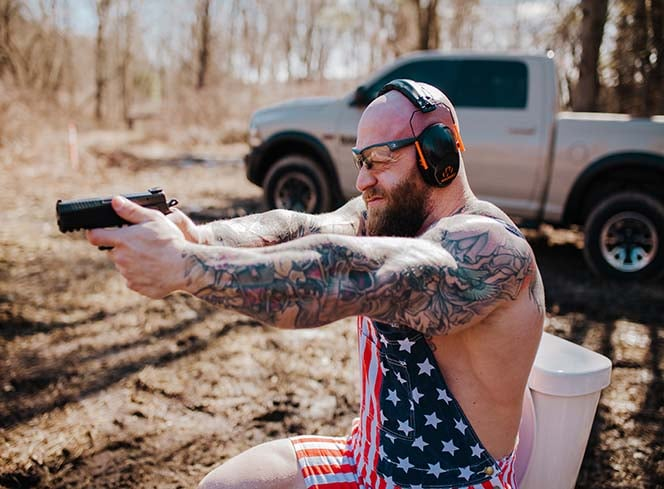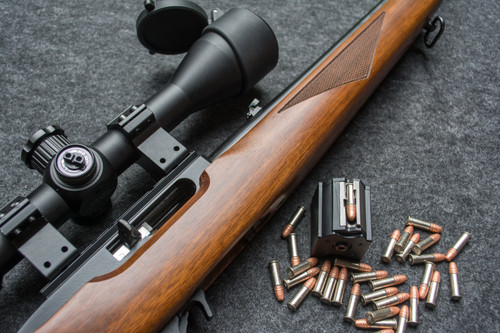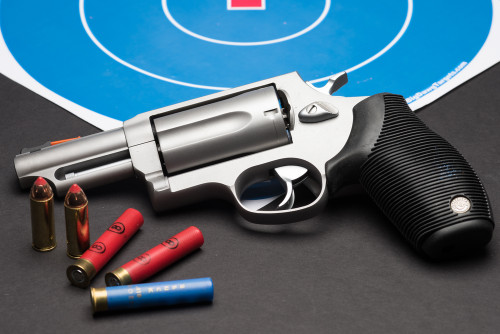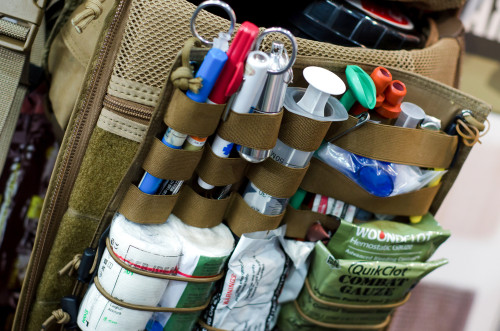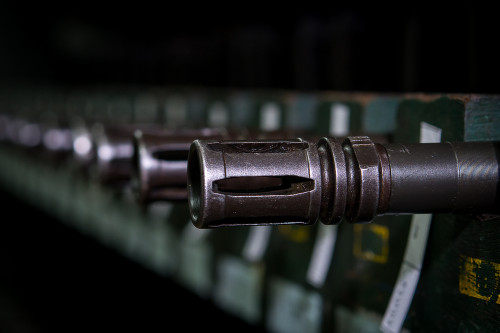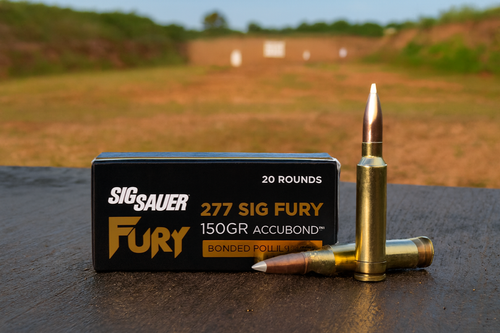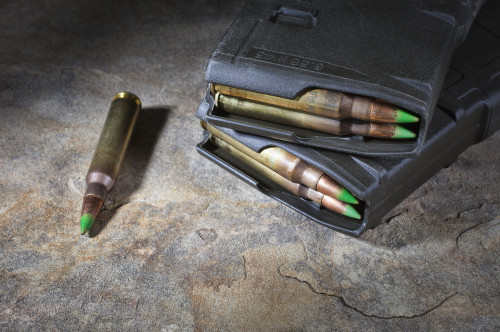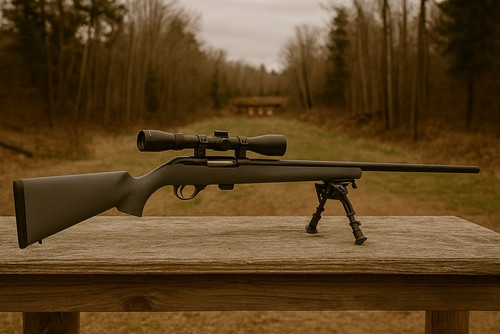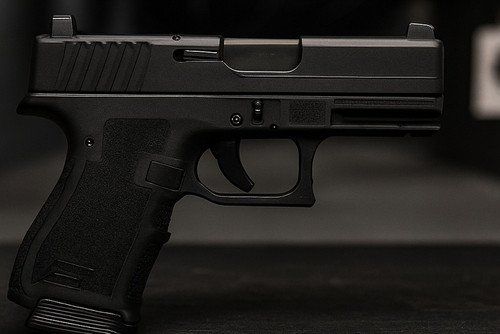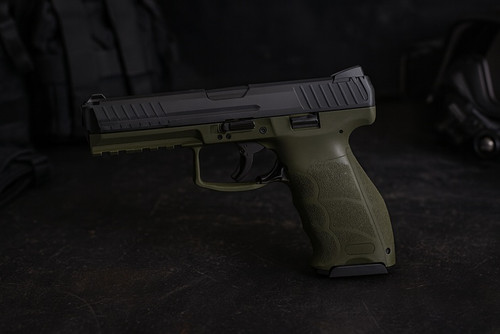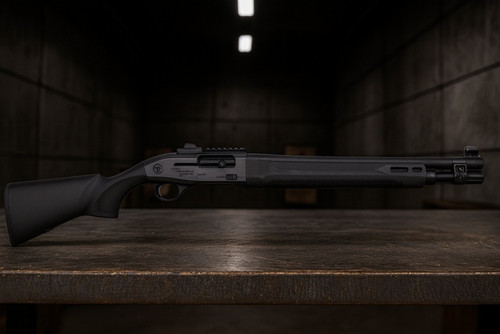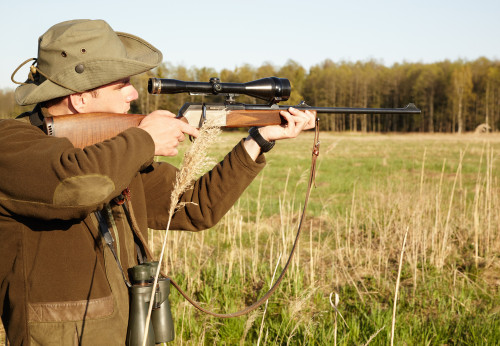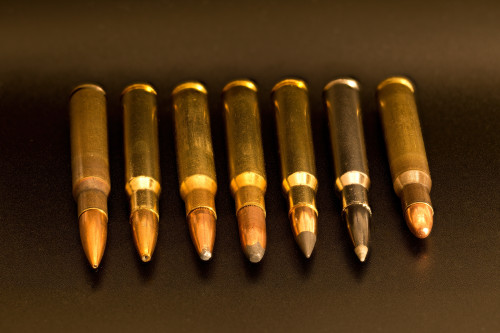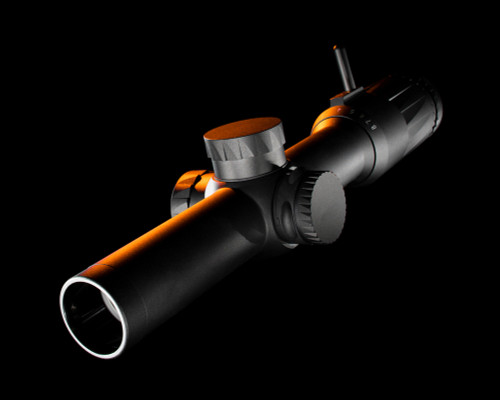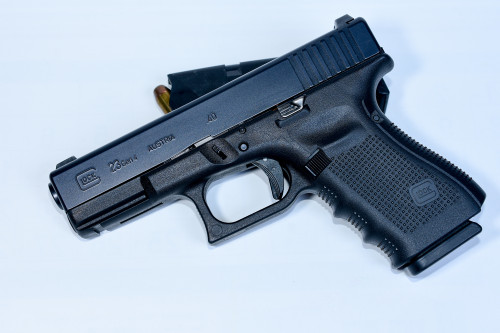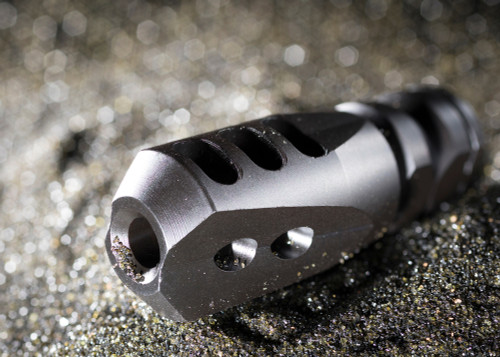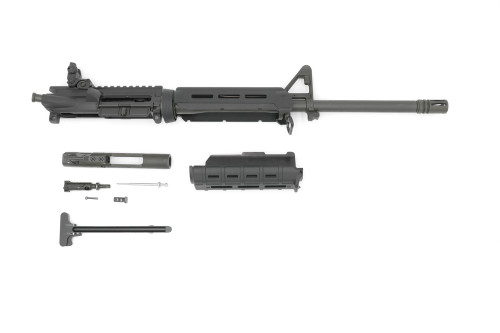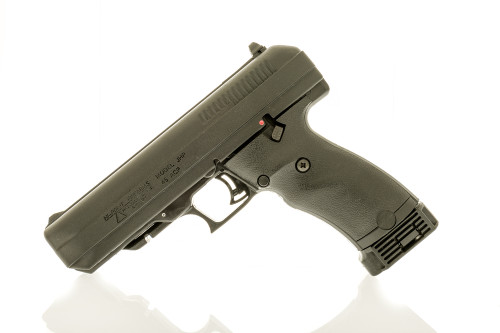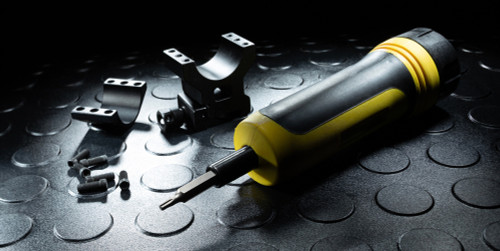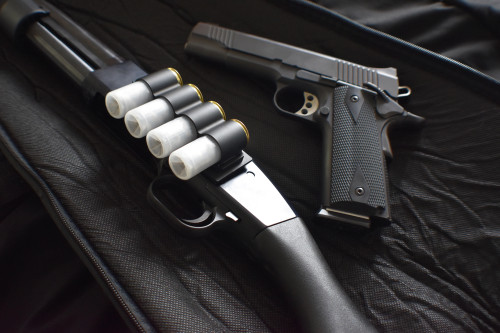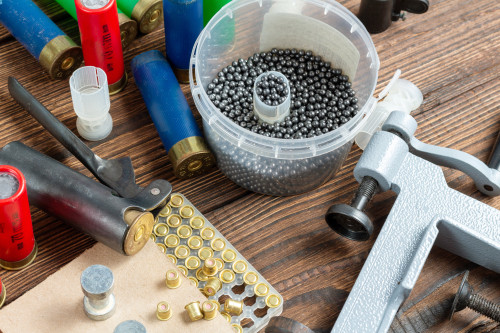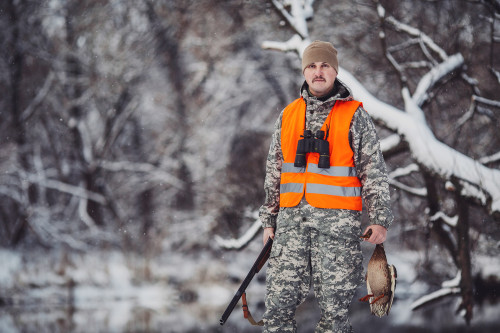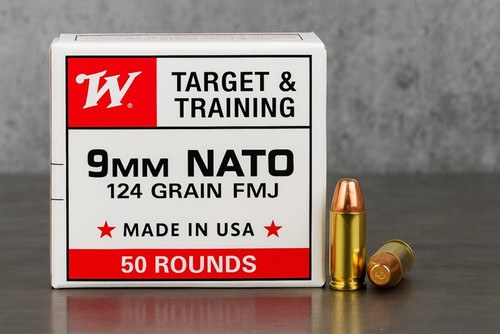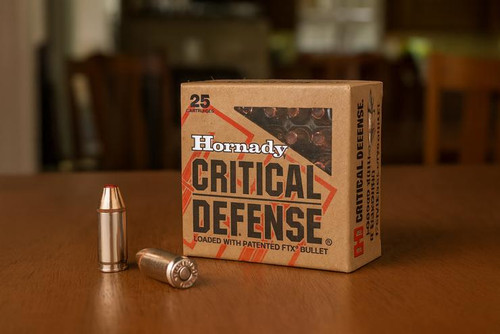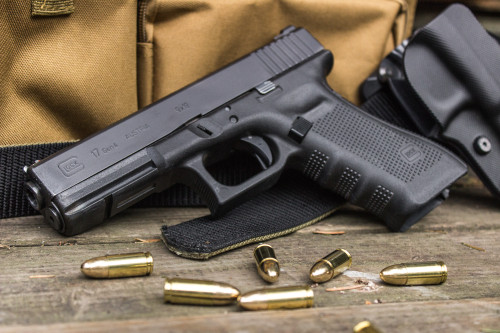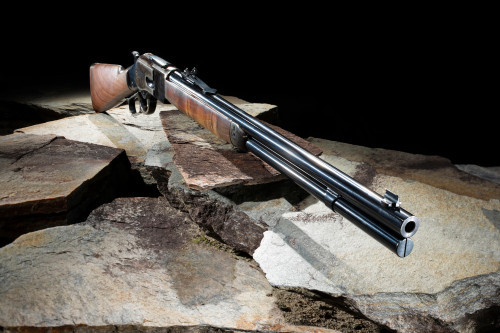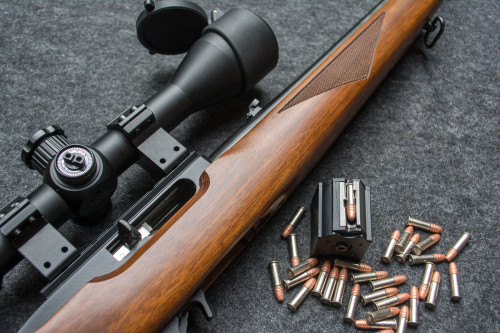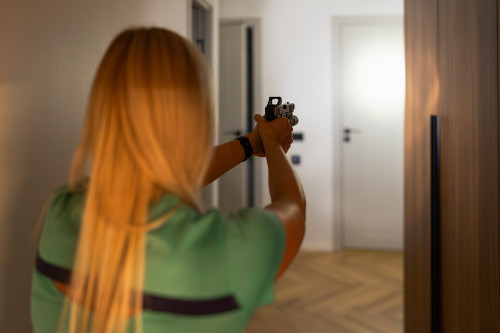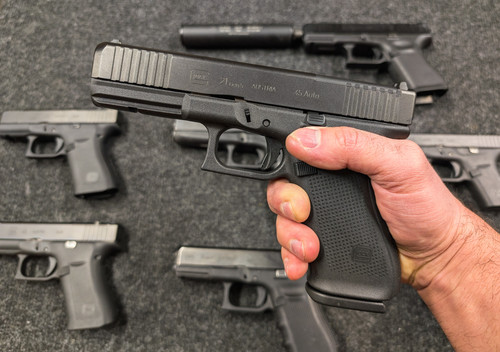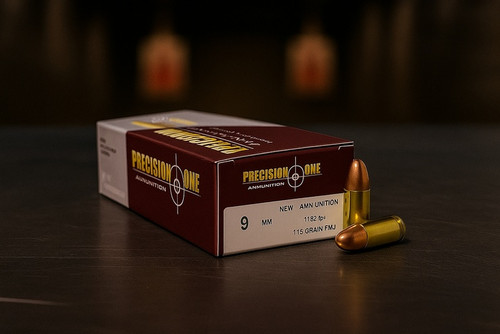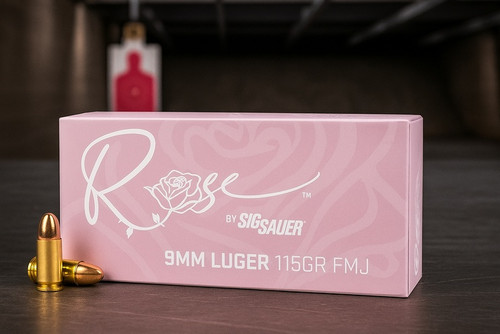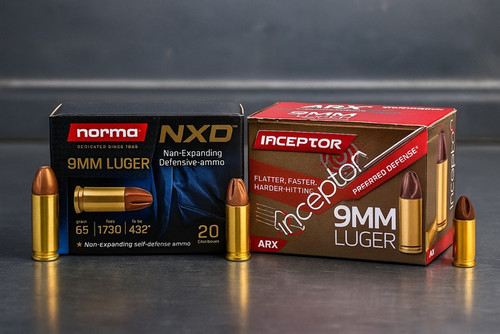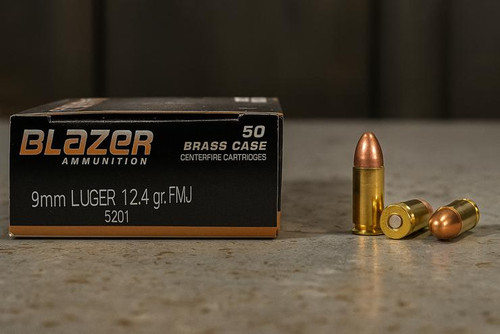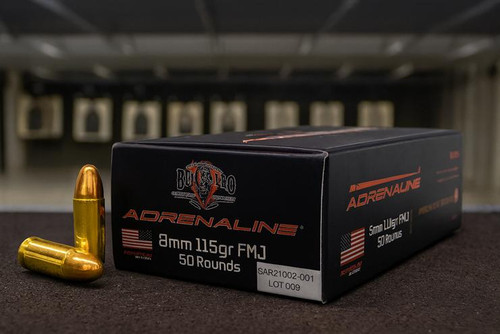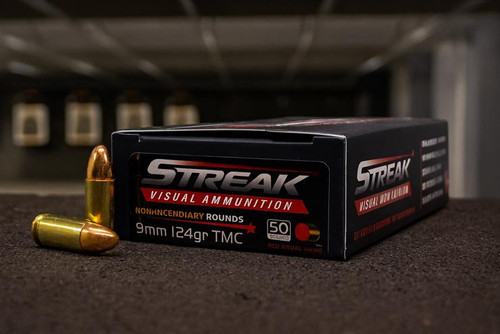In the United States, we enjoy unparalleled ease of access to firearms. Since the right to keep and bear arms is guaranteed by the Second Amendment, citizens in most states can acquire all manner of rifles, shotguns, and handguns with little to no bureaucratic hassle. In most cases, U.S. citizens are free to even manufacture the same items at home for personal use.
However, we are still restricted from purchasing or manufacturing certain types of firearms without navigating and complying with an arcane maze of federal regulations. Firearms such as machine guns, short-barreled rifles, short-barreled shotguns, silencers (legally defined as a firearm for some reason), disguised guns, and things like grenades and missiles are regulated by a nearly century-old law called the National Firearms Act (NFA) of 1934.
Originally overseen by the Alcohol Tax Unit of the IRS, this whole arcane legal business is now overseen by the Bureau Of Alcohol, Tobacco, Firearms, and Explosives, aka the ATF. Whether you’re seeking a Federal Firearms License or are just looking to acquire and collect NFA or “Class 3” items, you will interact with the ATF.
Legal hurdles aside, NFA items are most definitely the “cool kid toys” of the firearms world. Machine guns, silencers, compact SBRs — whether you acquire them for defensive use or collectible reasons, there’s just a lot of cultural cachet attached to NFA guns. Below, we’ll dive into the various kinds of NFA or “Class 3” items, as well as the paths to legally acquiring them, or even manufacturing them.
Legal Disclaimer
This article doesn’t constitute legal advice. For clarification, please cross-check the information here with actual federal, state, and local laws. If you have additional questions or concerns, we recommend consulting with a local attorney experienced in firearms law.
What Are NFA / Class 3 Firearms?
In order to understand the concept of class 3 firearms, it's first important to establish the precedent for gun control legislation over the years (however nonsensical it may be).
The National Firearms Act of 1934
The National Firearms Act of 1934 is the first major piece of gun control legislation in the history of the United States. Using some notorious Prohibition-era gangland shootings (such as the Valentine’s Day Massacre) as leverage, the federal government ratified this law in 1934. It was originally designed to regulate and tax almost every firearm in the United States.
However, the final version (scaled back since the original text was deemed a bridge too far Constitutionally) placed a heavy burden of taxation and registration on the owners of machine guns, short-barreled rifles, short-barreled shotguns, and silencers.
After the act was signed into law, all owners of these items had to pay a $200 tax to the IRS. That’s equivalent to about $4,637 in today’s dollars. They also had to register the item with the federal government.
As admitted by today’s ATF, the act itself was explicitly designed to deter the purchase and use of these items. Since the government could not ban the weapons outright due to the Second Amendment, the “power of the purse” (taxation) was used as an end-run, which was determined to be compliant with the Constitution, per se. Gun owners at the time went along with it, since machine guns and the like were considered the provenance of the rich anyway (i.e. if you could afford to feed a machine gun, you could afford a $200 tax on it).
The Federal Firearms Act of 1938
Further legislation followed, such as the Federal Firearms Act of 1938, which established the Federal Firearms License (FFL) system. The license became a requirement for those who commercially manufactured, imported, or sold firearms (mostly in a business sense) in the United States. This act established the recordkeeping requirements for FFLs, and also defined the first instance of a “prohibited person” (i.e. someone who cannot legally possess a firearm). Since NFA items were now exclusively legally sold via FFLs, they became the go-to people for these weapons.
The Gun Control Act of 1968
The 1968 Gun Control Act (GCA) added further complications to the acquisition of NFA weapons. Not only did it impose age requirements on the purchasing of all firearms, it also severely restricted the importation of all firearms, even for those who had the funds and willingness to navigate the NFA process.
For example, prior to 1968, you could have an FFL import a brand-new Beretta Model 12, a submachine gun, from Italy, and take possession of it after completing the NFA process. After the “sporting purposes” restrictions implemented by the GCA, weapons that were not suitable for hunting, target shooting, and the like, could not be imported for sale to individuals in the US. An FFL could import a Beretta Model 12, but the end user would have to be a government entity such as a police force or a military unit.
Class 3 Firearms
In 1986, the Tax Code was amended to introduce the Special Occupational Taxpayer (SOT) classifications for FFLs. Consisting of 3 “classes”, an additional yearly $500 tax was assessed on FFLs who dealt with NFA firearms. The most common “class” is “Class 3”, which is for FFLs who sell NFA firearms. Ostensibly, this is where the term “Class 3 License” originated, however the term itself really refers to the tax class — not a license.
In conversation, you will see the terms “Class 3” and “NFA” used interchangeably, with Class 3 being more of a slang term. While calling a machine gun a “Class 3” gun is technically incorrect, the overall meaning (i.e. this weapon is regulated by the NFA) remains the same. However, you may get some blowback from internet gun gurus!
Types of NFA Firearms
To play in the NFA and “Class 3” world, you must be keenly aware of the types of firearms covered by the act. Also, it’s crucial to know how even simple and common components (such as auto sears) are legally considered NFA firearms. That means a $20 purchase from your favorite online gun outlet could unknowingly turn you into a felon. Here are the categories of “Class 3” firearms, broken down:
Machine Guns
Whether it’s a classic Tommy Gun or an M16, machine guns are the supreme objects of desire in the firearms world. When it comes to NFA items, most people in the know will instantly think “machine gun.”
Machine guns are defined in federal law as any firearm which discharges multiple rounds with a single movement of the trigger (press or release). That distinction is important because it means a binary trigger-equipped gun which shoots one round on a press, one round on a release is not considered a machine gun. However, if you press and hold the trigger down and multiple rounds are discharged — that’s a machine gun. Whether it’s 3 rounds (i.e. a burst function) or 30 (full-auto emptying a magazine), it’s legally a machine gun.
Confusingly, some machine gun parts are legally classified as machine guns in and of themselves, such as:
- Auto Sears: The component which times the hammer for full auto operation in a firearm would be classified as a machine gun all by itself. An auto sear can be ordered without a background check, but you must be legally able to receive it, either by having a registered machine gun (you purchased a new sear as a spare) or you are an FFL of the proper SOT class (more on that later) that deals in or makes machine guns. Just having an auto sear in your possession without meeting either of those two requirements could land you in serious legal trouble.
- Full-Auto Receivers: Any receiver that’s expressly configured to hold full auto components without further modification to the receiver is also considered a machine gun. In this case the government issued an executive order changing the definition of the term “machine gun,” classifying receivers (configured for full auto) as machine guns. You’ll see comments on the internet referring to “receivers with the third hole drilled.” This refers to AR-15 receivers that have been modified to accept full auto components. Drilling that third hole is unfortunately a crime unless you are an FFL.
- Bump Stocks: As of this writing, bump stocks are also classified as machine guns, despite not modifying the trigger function of an AR-15 in any way. The device allows you to “bump fire” (rapidly depress the trigger) to near full-auto speeds. But due to a controversial 2018 executive order by President Donald Trump, bump stocks were classified as machine guns in March of 2019. However, on February 28th, 2024, Garland v Cargill was heard by the Supreme Court, and a ruling reversing this executive order could be in place by the summer of 2024.
Silencers
An oddity of the National Firearms Act is that it does regulate items that are simply not firearms at all, like silencers. More popularly known as suppressors, these devices are essentially mufflers for guns. There’s scant evidence as to why silencers were added to the NFA, but most seem to think poaching was the excuse.
Anyway, a suppressor muffles the sound and report of a gunshot using a system of high-strength baffles in a pipe. A good silencer will shave between 30-40 decibels off the roughly 160 decibels of the average gunshot. The sound is still loud, but the initial “boom” out of the barrel will be muffled.
Legally, a suppressor is called a “silencer”. It is referred to this way in the law and also on the required forms that need to be filed for purchase. Regardless of name, it is regulated by the National Firearms Act in the same manner as a machine gun.
Silencers are the most popular National Firearms Act item, with millions currently in circulation. As such, concentrated efforts are underway to deregulate them, to make them no more legally distinct than any other firearm accessory.
Short-Barrled Rifles
Originally, the National Firearms Act was to demand registration and a $200 tax of almost every firearm in the United States, save for some shotguns and rifles. You’d be surprised by the first draft of the NFA, which was staggering in its scope and implications, as it even covered handguns. Since there was that small exemption regarding some shotguns and rifles, the Short-Barreled Rifle (SBR) classification was written into the law. This was because the authors of the act did not want people evading the law by merely cutting down an exempt rifle or shotgun to make an improvised “legal” pistol.
However, the final revision of the act dropped the registration and taxation requirement on most firearms. Ironically, the SBR classification stayed in place, despite its original purpose being rendered moot.
Regardless, the SBR classification still stands, and its definition is pretty clear. An SBR is any firearm with a rifled barrel of 16 inches or less that also has a proper stock. Also, the overall length of the firearm must be 26 inches or greater, or it’s an SBR, regardless of barrel length.
In a convoluted executive order pushed forth in 2023, braced pistols chambered in rifle calibers (such as AR-style pistols) were deemed to be SBRs as well. Currently, several injunctions are in place, such as the Mock v Garland injunction, and AR-style pistols may be freely made and sold with no more hassle than any other non-NFA firearm.
Short-Barreled Shotguns
Similarly to SBRs, short-barreled shotguns (aka SBS) are also regulated by the National Firearms Act. The measurement requirements are slightly different though, with the barrel length cutoff being 18 inches as opposed to 16 inches, if the shotgun is fitted with a proper stock. The overall length requirement is the same, at 26 inches, regardless of barrel length.
YThere are some edge cases, like the Mossberg Shockwave. This model has a 14 inch barrel, but is not considered an NFA or “Class 3” firearm. This is unique because firearms like the Shockwave are legally not considered shotguns. They are in the “other” category. Basically the Shockwave has a rather interesting handle for a “grip” that pushes the overall length to over 26 inches. It has no stock and no pistol grip (that’s a gray area, too) — therefore it’s not an NFA item.
Destructive Devices
If you are really looking to make a statement, this category of NFA items is definitely for you. Destructive devices are literally the big guns. Under the act, any firearm with a rifled barrel chambered in a caliber greater than .50 is a destructive device, regardless of action (auto, semi-auto, bolt-action, single shot) or barrel length.
Specific exemptions exist for certain hunting weapons, such as safari rifles chambered in 700 Nitro Express. Of course, your common 12-gauge shotgun can shoot a slug that’s bigger than .50 caliber, but since the barrel isn’t rifled, it’s not considered a destructive device. However, the ATF has deemed individual shotguns such as the Cobray Street Sweeper to be destructive devices. At the same time, this ruling is currently not contested as Cobray no longer exists.
The most common firearms deemed as destructive devices are vintage anti-materiel rifles like the Lahti L-39, a positively beastly Finnish anti-tank gun from World War II chambered in 20mm. Also, for some real fun, you can legally own hand grenades as long as you register them as destructive devices. Unfortunately, each grenade is considered a destructive device, so a six-pack will have a $1200 tax on top of the cost of the grenades themselves.
Along the same lines, a grenade launcher such as the 40mm LMT M203 is a destructive device, and yes, each 40mm explosive projectile is also considered a destructive device. An NFA hobby can get very expensive.
If you choose to indulge in the “DD” category extensively, the government may impose other requirements on you, such as mandatory explosives storage containers and a federal explosives license.
Any Other Weapons
Some of the most interesting weapons in the world fall into this arcane NFA or “Class 3” category. Within that, the Any Other Weapons (AOW) category covers a vague range of firearms, including:
- (Most) Disguised Weapons: Including cane guns, guns that look like cell phones, pen guns, and all those little secret spy gadget guns that turn up on auction sites.
- Weird Guns: The ATF also likes to throw in “normal” weapons that defy easy classification like the Serbu Super Shorty, a 12-gauge pistol grip-only shotgun with a 6.5 inch barrel and a vertical foregrip. Legally considered a “smoothbore handgun,” the Shorty is a crowd favorite, since it’s basically a really loud pistol.
- Guns With Vertical Foregrips: One of the main factors that puts the Serbu Super Shorty into the NFA category is the vertical foregrip. If you for some reason put a vertical foregrip on your pistol (whether it be a GLOCK or an AR-style pistol), it then becomes an NFA or “Class 3” item.
Interestingly enough, AOWs only require a $5 tax payment (as the result of a small revision to the NFA in 1960), so technically you could enter the NFA space by getting a Super Shorty.
How To Acquire or Manufacture NFA Firearms
There are two specific routes to getting into the world of NFA & Class 3 firearms:
- The FFL Route: You obtain a Federal Firearms License (FFL), file to pay the appropriate SOT tax, and set yourself up as a commercial enterprise in the firearms world.
- The Individual/Trust Route: You pick the NFA item you want, fill out the requisite ATF Forms, gather the ancillary paperwork, pay the $200 tax on the item, submit it all, and wait for the ATF’s go-ahead.
But first, you need to determine if NFA firearms are legal for individual (or trust) ownership in your state. While such a concept does fly in the face of established constitutional concepts (the federal Constitution establishes the limits of gun laws in theory), states have ignored these concepts for decades. Some have outright banned the individual ownership of NFA firearms. In these states, the only route open to you is the FFL route.
Also, your goals within the NFA space will dictate your route. If your plan is to merely collect things such as silencers, pre-86 machine guns, and SBRs, keeping things under your name or the name of a trust may be the best route. If your goal is to explore and develop your knowledge of firearms design, build new machine guns, and to conduct business in the space, the FFL route is for you.
The FFL Route
Getting an FFL at first may seem to be the “dream” route for the serious firearms enthusiast. You’ll get guns at lower prices, and state-level restrictions on firearms generally won’t apply to you. But in reality, acquiring and maintaining an FFL imposes a significant financial and administrative burden.
In past decades, many American gun enthusiasts would get an FFL specifically to expedite the purchase of firearms and enrich their own collection. However, in the 1990s, the ATF cracked down on these “kitchen table” FFLs. Now, the ATF demands a higher burden of “proof” to receive an FFL. The new rule is that if you can pass a firearms background check (NICS), the ATF will issue you an FFL. However, there is a lot more involved.
Before issuing your FFL, the ATF will check to ensure you are actually intending on going into the business of firearms, and not just looking to stockpile guns. While the nuances vary, the ATF’s Industry Operations Investigator (IOI) assigned to you will want to see proof that:
- You have a business (LLC paperwork, etc.)
- You are authorized to establish a firearms business in your location (i.e. local zoning)
- You have safe storage arranged for your inventory
- You understand how to stay compliant with current laws and rulings concerning firearms
After they are satisfied these terms are met, and you have passed your background check, an FFL will be issued to you.
Now, an FFL isn’t just one license. There are several types of FFLs, and if you plan on being in the NFA game, you’ll need to be an SOT (Special Occupational Taxpayer) of which there are three classes.
Types of FFLs and Costs
Here’s a table showing the types of FFLs available, what they allow the licensee to do, and the tri-annual cost of renewal.
| Type | Name | Usage | Cost/Renewal Per 3 Years |
|---|---|---|---|
| Type 1 | Dealer in Firearms Other Than Destructive Devices (Includes Gunsmiths) | Dealer or gunsmith other than DDs. Can also deal in NFA firearms with an SOT Class 3 status. | $200/$90 |
| Type 2 | Pawnbroker in Firearms Other Than Destructive Devices | Title 1 dealer doing business as a pawnbroker. | $200/$90 |
| Type 3 | Collector of Curios and Relics | Licensed collector of Curio & Relic (C&R) firearms. This is specifically for collecting antique guns. | $30/$30 |
| Type 5 | Manufacturer of Ammunition for Firearms | Licensed manufacturer of ammunition and reloading components other than ammunition for destructive devices and armor-piercing ammo. | No longer used |
| Type 6 | Manufacturer of Ammunition for Firearms | Licensed manufacturer of ammunition other than ammunition for destructive devices and armor-piercing ammo. This license only allows the holder to manufacture ammunition. | $30/30 |
| Type 7 | Manufacturer of Firearms Other Than Destructive Devices | Manufacturer of firearms and ammunition, who may also act as dealer; may not manufacture or deal in destructive devices, ammunition for destructive devices, or armor-piercing ammunition. Can also manufacture & deal in NFA firearms with an SOT Class 2 status. | $150/$150 |
| Type 8 | Importer of Firearms Other Than Destructive Devices | Importer of Title 1 firearms and ammunition. Can also import NFA firearms with an SOT Class 1 status. Type 8 is also Title 1 dealer or gunsmith. | $150/$150 |
| Type 9 | Dealer in Destructive Devices | Dealer in firearms, including destructive devices, ammunition for destructive devices, and armor-piercing ammunition. Requires payment as an SOT Class 3 (can act as an NFA Dealer). To deal/broker any DD with an explosives content (e.g. flash-bangs) requires an additional Federal Explosives License (FEL) as a Dealer of High Explosives. | $3000/$3000 |
| Type 10 | Manufacturer of Destructive Devices | Manufacturer of firearms, ammunition, and ammunition components, manufacturer of destructive devices, ammunition for destructive devices, and armor-piercing ammunition; may also deal in all of the aforementioned items. Requires payment as an SOT Class 2 (can act as an NFA Dealer). To manufacture any DD with an explosive content (e.g. flash-bangs) requires an additional FEL as a Type 20 Manufacturer of High Explosives. | $3000/$3000 |
| Type 11 | Importer of Destructive Devices | Importer of firearms, ammunition, destructive devices, ammunition for destructive devices, and armor-piercing ammunition; may also deal in all the aforementioned items. Requires payment as an SOT Class 1. To import any DD with an explosive content (e.g. flash-bangs), requires an additional FEL as an Importer of High Explosives. | $3000/$3000 |
Special Occupational Taxpayer (SOT) Classes and Costs
Here’s a table showing the three classes of Special Occupational Taxpayer (SOT) Classes and how much they cost.
| Class | Usage | Cost |
|---|---|---|
| Class 1 | Importer of NFA firearms | $1000 if revenue is above $500K per year, $500 if less. |
| Class 2 | Manufacturer & dealer of NFA firearms | $1000 if revenue is above $500K per year, $500 if less. |
| Class 3 | Dealer of NFA firearms | $500 regardless of revenue. |
As you can see, there is a whole host of FFL and SOT options. Your category will depend upon your business intent within the firearms world. Most people choose to be manufacturers or dealers. The import game is an entirely different universe aside from the FFL/SOT requirements, and would be beyond the scope of this article. There are only a few importers doing business in the US, whereas most FFLs are dealers and manufacturers.
With this many options and hoops to jump through, there is no perfect route to take for licensing — but each helps you achieve goals legally. Luckily, 2A enthusiasts like yourself have been navigating this complexity ever since the first firearms act, and there are two common paths used time and time again, depending on your goals as a firearms owner.
Path A: Type 1 FFL With SOT Class 3
If your intent is to trade in NFA items, your best bet is to get a Type 1 FFL with an SOT Class 3. In common parlance, you’ll be an 01/03 FFL. You’ll be able to sell normal firearms like GLOCK pistols and AR-15s, and also NFA items like suppressors, SBRs, and pre-86 machine guns.
You’ll be able to acquire post-86 (new) machine guns, but they can only be sent to you if a government entity such as a police department requests a demonstration of the machine gun in question. For example, if your place of business is Plano, Texas, and you want an HK 416 machine gun in your inventory, the Plano PD or similar nearby department would have to provide what’s known as a “demo letter” requesting that Heckler & Koch send you an HK 416 machine gun for demonstration purposes. Even this is only likely if you (as a business owner) have an established relationship with someone important in your local government or police department to warrant such a request. NOTE: In this case, the machine gun belongs to your business and not you, since machine guns made after May 19th, 1986 cannot be owned by individuals.
A Type 1 FFL also legally permits you to perform gunsmithing services. You can take possession of a gun owner’s firearm, repair it or upgrade it, and give it back to them after services and payment are rendered. However, you cannot manufacture a new firearm for resale.
Path B: Type 7 FFL With SOT Class 2
If your intent is to deal and manufacture non-NFA and NFA firearms, you’ll want to get a Type 7 FFL with an SOT Class 2. You’ll be known in the industry as an 07/02 FFL, for short.
You’ll be able to not only deal in non-NFA and NFA firearms, but make them as well. Whether you have a full-blown facility with Haas CNC machines and staff, or just a small warehouse with a store up front and some lathes and drill presses in the back, you’ll be able to really put your hands to work and manufacture firearms. This includes brand-new machine guns! For the inventive sort, this is the way.
However, even if you make machine guns yourself, they cannot be sold to anyone but another FFL (01/03 or 07/02) when accompanied by the proper paperwork. Also, when you manufacture a machine gun, you must electronically file a Form 2 with the ATF within 48 hours of the completion of the firearm. Also, the business technically owns the weapon (not you).
It gets even more complex if you manufacture 50 or more firearms in a given year, as you’ll have to pay an 11 percent excise tax to the Tax and Trade Bureau. Even then, the government still won’t be done with you. In most cases, you’ll have to pay $2250 per year to the State Department to comply with the International Traffic in Arms Regulations (ITAR), even if you don’t sell anything overseas.
FFL Administrative Burdens
Costs and taxes aside, the biggest burden for an FFL is insanely accurate recordkeeping. These days, the ATF has adopted a zero-tolerance policy for errors, so accuracy is of critical importance. Repeated violations could mean loss of your FFL, loss of your inventory, and potential prison time.
The biggest compliance hurdle is your requirement to conduct a background check on almost every prospective buyer of every firearm you sell (NFA or otherwise). In most cases, it will look like this:
- You’ll need to have the purchaser fill out the Form 4473, where they’ll record their personal information, and answer a few compliance questions. You’ll then record the relevant information about the firearm or firearms being transferred. This goes for NFA items too, but in most cases the ATF does the background check on their end directly, so here the 4473 is the end of the process for a buyer.
- You will use your computer to input the buyer’s personally identifiable information into the web portal for the FBI National Instant Check System aka NICS. While some states run their own portals, they all connect to similar databases, so most people call it NICS.
- The NICS system will give you the go/no-go/delay signal for a firearms purchase. If you get the green light, the person can pay and take their new toy home. If you get a red light, no sale. If the inquiry is delayed, it means someone at the FBI has to verify some details. Also as of right now, if a buyer is between 18-21 years old, they will automatically receive a 10-day delay before the purchase is confirmed or denied.
- Your job is to ensure Form 4473 is accurately filled out, the status of the NICS inquiry is recorded, and you are safely filing it away for future possible inquiries from law enforcement. Since for non-NFA guns a central firearms registry in the United States is prohibited by the FOPA law, the Form 4473 is the only evidence of the entrance of a firearm into consumer hands.
- You’ll also have to maintain what’s called a “bound book” in industry terms. In this book (or spreadsheet) you’ll have to note the status of every firearm you’ve ever had in your FFL inventory. When a firearm comes into your business (acquisition) you’ll note the date, the specific firearm, and its serial number. When the firearm is transferred out of your inventory, you’ll have to note the date, the details of the firearm (including serial, etc) and where it went, including cross-referencing it with the correct Form 4473.
You’ll also have to comply with periodic ATF inspections, as well as any law enforcement inquiries. Sounds fun, right?
The NFA Transfer Route
The FFL process is really only intended for those who wish to be in the business of firearms. Even if the Clinton-era crackdown on casual “kitchen table” FFLs hadn’t happened in the 1990s, the paperwork burden alone would scare most hobby collectors away. Completing the individual/trust NFA transfer process is the way to go for the occasional buyer of NFA and “Class 3” firearms.
Before you start the National Firearms Act registration process, collect the relevant details of your NFA item. The ATF forms require some details for your NFA item to be transferred to you. Your NFA dealer will provide you with the relevant specifications so you can fill out the ATF Form 4 correctly. A Form 4 is for transferring an already-manufactured item.
If you want to make your own NFA item such as an SBR, SBS, or suppressor (which you can make for personal use) you can gather the specifications from the parts you’re using. For example, if you make an SBR, you’ll know its caliber, overall length, and barrel length based on the parts you acquire. If you make your own silencer, you’ll know the caliber and length easily from the parts you plan on buying. Then you can fill out your ATF Form 1 correctly. The Form 1 is for those who make NFA items for their own personal use. Remember, if you make an NFA item, your personal details (or trust details) need to be engraved on it before the item is legally complete.
Note on Constructive Possession
A word of advice if you choose to make an NFA item. The ATF has prosecuted people for what is known as “constructive possession”. Basically, if you have all the components to make an NFA item, you may as well have a complete one in their eyes.
For example, if you have the tube and baffles for a suppressor, even if they aren’t drilled out, the ATF will consider you as having a suppressor, even though it isn’t built. Or, if you have all the components for an SBR, they may treat you as if you had a complete, untaxed, unregistered SBR.
To prevent this, most makers purchase the critical components for when the form comes back approved. For example, for an SBR, you can buy everything but the trigger and fire control selector — without those two parts, the rifle won’t function. Or some go even further and just acquire a lower receiver, spec out the remaining parts online, and obtain the length from the descriptions. Then, when the form comes back approved, they purchase the remaining parts. For someone choosing to build their own silencer, they will just get the length and caliber of the tube from online sources.
The Individual NFA Process
The process of acquiring or making an NFA firearm for your individual use is complex, but far easier than the FFL route. The ATF Forms are pretty straightforward, and as of this writing, are all available on the ATF’s eForms portal and can be done electronically. Here’s how that process looks:
Step 1: Fill Out ATF Form 4
You’ll need the name of your jurisdiction’s chief law enforcement officer, to notify them that you possess an NFA item. (The State Attorney counts for this, by the way). You’ll also need a 2x2 passport photo of yourself, along with a completed FD-258 fingerprint card to attach to the form either digitally or for real.
Step 2: Submit a Tax Payment
Once the form is completely filled out, you’ll need to submit a tax payment to the tune of $200. If you’re using the ATF eForms portal, it’s just another e-commerce checkout process, where you can use your credit card. If you are filling out your form on paper, include a check or money order with the form.
Pro Tip: Use a money order since it’s as good as cash and the IRS (The IRS takes the payment, the ATF processes the form) will immediately mark the form as paid.
Step 3: Background Checks
After that, the ATF contacts the FBI and a normal firearms background check is performed on you. Then, clerks at the NFA Division of the ATF will examine your Form 1 and any other associated paperwork and check for accuracy. This process is done by hand and it is primarily where the delay happens.
Then, your item will be registered or its entry updated in a federal database known as the National Firearms Registration And Transfer Record (NFRTR). Federal law prohibits a central registry of firearms in the US, except for NFA items.
Step 4: Obtain Your NFA Item
After many months of waiting, you’ll receive a notification from the ATF via email or postal mail that your form has been approved. The form will be stamped (digital for the eForm PDF), confirming that you paid the $200 (or $5 for an AOW) tax, and an approval signature from an ATF official. Only then can you legally possess or make your NFA item.
The Trust NFA Process
With the individual route, there are some limitations. When you filled out the form, you did so as an individual. The NFA item is registered to you in a federal database. Legally, this means the weapon cannot be used by someone else unless you are immediately present. For example, if you go to the range with your wife, she can use the NFA item. However, she cannot take the item to the range on her own. It’s even legally questionable whether she can have access to the safe that your NFA item is stored in.
In most gun-owning households, all the adults and the suitably-briefed children will have firearms access. To avoid legal complications, what is an NFA owner to do? Gun trusts are about the only answer.
What Is a Gun Trust?
A legal trust is similar to a corporation. The trust is an entity consisting of multiple people who need to access certain items or funds. Thankfully, due to the work of enterprising lawyers such as David Goldman, “gun trusts'' are a thing.
A gun trust is basically a preformatted document that includes all the legal language you need to place your NFA items under the control of the trust. In the trust, you define who can lawfully possess your NFA items, and the disposition of those NFA items after your death.
Legally, the trust is the owning entity of the firearm, as much as a computer in a bank belongs to the bank and not a specific owner/officer of the bank. Your gun trust, if you go this route, makes legal possession of an NFA super easy for anyone you authorize to use it, regardless if you are present or not.
Are Gun Trusts Subject to Background Checks?
Yes and no. Since a trust isn’t a living and breathing entity, it cannot be subject to a background check. However, an extra step is required (or more, depending on how many people are on the trust).
If you choose the trust route, the ATF eForms will prompt for this step, where everyone named on the trust must fill out the supplementary Responsible Person Questionnaire, which requires a photograph and FBI fingerprint cards. So, if you are granting access to three people besides yourself, four photographs and four FBI fingerprint cards will need to be scanned and submitted to the ATF.
TIP: You can purchase FD-250 fingerprint cards online at Amazon. As long as you follow proper printing procedures, the ATF will accept them. Also note that a local notary will need to notarize your gun trust for a small fee.
The questionnaire will have the personal information of all trustees so the ATF can pass their information to the FBI and have background checks performed. To be blunt, if you are placing people on your gun trust, make sure they can pass a firearms background check first. If one person on the trust fails the background check, the ATF will reject the entire form package, and you will have to start all over again from step 1, except with the prohibited person removed from the process.
After submission and payment, the wait begins. An electronic Form 1 takes 40 days to process and approve, provided all fields are filled out accurately and correctly. A paper form takes 90 days. Unfortunately a Form 4 item like a suppressor, machine gun, or destructive device, takes over 220 days, even electronically.
Final Thoughts
While many agree that the National Firearms Act represents a violation of the Second Amendment (especially after the 2022 Bruen decision by the Supreme Court), there’s no real way around these laws for now. Unfortunately, that means obtaining NFA or Class 3 firearms is a highly restricted process. It also imposes a significant legal burden on the owner(s) — especially for those with an FFL who choose to make a business out of it. But if you want to do the NFA “dance,” you’ll need to comply with all aspects of the National Firearms Act, and gun laws in general.
That said, owning an NFA or Class 3 firearm is badass.
These are some of the coolest weapons on the market, and being an owner of such an item can be personally and financially rewarding. That’s not to mention the cultural cachet that comes with these items. If it’s something you’re truly passionate about, it might be worth navigating the maze of paperwork and taxes.
At Pro Armory, our mission is to provide you with the knowledge and equipment necessary to make the most of your gun collection. We offer bulk ammo and quality tactical accessories at great prices. We also offer online training from veterans and professional shooters to help you become more proficient and safe with all of your firearms. Sign up for our newsletter to learn more about what we’re doing to support the Second Amendment.




